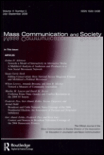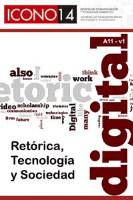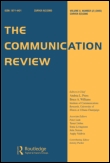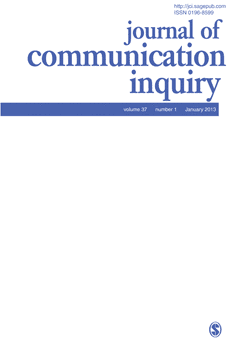
TRIPLEC-Communication Capitalism & Critique
Scope & Guideline
Advancing Open Access Research in Communication Studies
Introduction
Aims and Scopes
- Critical Political Economy:
The journal emphasizes a critical political economy approach, examining how communication technologies and media practices are influenced by and contribute to capitalist structures. - Digital Labour and Capitalism:
A significant focus is on the concept of digital labour, exploring how work, value, and exploitation manifest in the digital economy and how they shape social relations. - Media and Democracy:
Investigating the role of media in democratic processes, the journal addresses issues like media concentration, the public sphere, and the implications of digital media for civic engagement. - Alternative Media and Economies:
The journal explores the potential of alternative media and economic models to resist dominant capitalist narratives and practices, fostering discussions around new forms of media and community engagement. - Technological Critique:
There is a consistent critique of technological determinism, focusing on how technologies can both reinforce and challenge existing power structures within capitalism. - Ecological Perspectives:
The journal also incorporates ecological critiques, examining the relationship between capitalism, communication, and ecological crises, and the role of media in shaping environmental discourse.
Trending and Emerging
- Digital Capitalism and AI:
A growing theme is the intersection of digital capitalism with artificial intelligence, particularly in terms of class struggles and the implications for labour and social equity. - Platform Cooperativism:
Emerging discussions around platform cooperativism highlight alternative economic models that challenge traditional capitalist frameworks, reflecting a shift towards community-oriented digital economies. - Racial and Social Justice in Digital Spaces:
Recent publications increasingly address issues of racism, algorithmic bias, and social justice within digital capitalism, emphasizing the need for equity and inclusivity in technological advancements. - Ecological and Ethical Considerations:
There is an increasing focus on the ecological implications of digital capitalism, exploring ethics, sustainability, and the role of media in environmental discourse. - Gig Economy and Labour Organizing:
The gig economy has become a central topic, with analyses of worker organizing, mobilization, and resistance strategies in the context of precarious work conditions.
Declining or Waning
- Traditional Media Critique:
There seems to be a declining focus on traditional media critiques, particularly concerning legacy media institutions, as the discourse shifts towards digital platforms and their impact. - Purely Theoretical Discussions:
The journal has moved away from abstract theoretical discussions that lack empirical grounding, favoring more applied and context-driven analyses of digital capitalism. - Historical Analyses of Media:
There is a noticeable decrease in papers that engage deeply with historical analyses of media, as the emphasis has shifted towards contemporary issues and future-oriented discussions. - Niche Cultural Studies:
Niche cultural studies topics, which were once prevalent, are now less frequently addressed, possibly due to a broader integration of cultural critique within the larger framework of digital capitalism.
Similar Journals

Plaridel
Exploring New Frontiers in Communication Research.Plaridel is an esteemed academic journal dedicated to the field of communication, published by the University of the Philippines Diliman. With the ISSN 1656-2534, this journal embraces a significant role in fostering scholarly dialogue and advancing research within the rapidly evolving landscape of communication studies. As one of the platforms in the Philippines, it aims to uplift local and international discourse by featuring innovative research, critical reviews, and theoretical explorations relevant to various facets of communication. Although currently rated in the Q4 quartile for 2023 in the Communication category, Plaridel's commitment to quality and scholarly rigor reflects a promising trajectory for future impact. The journal has been operational since 2018 and welcomes a wide array of contributions, especially from emerging scholars. Open access provides greater accessibility to researchers and enthusiasts, promoting broader engagement with the journal’s content. Plaridel holds an important place within the academic community, aspiring to elevate standards of communication research and practice in the Philippines and beyond.

Mass Communication and Society
Shaping Understanding of Communication's Role in SocietyMass Communication and Society is an esteemed journal published by Routledge Journals, Taylor & Francis Ltd, focusing on the dynamic field of communication studies. With its ISSN 1520-5436 and E-ISSN 1532-7825, the journal has established itself as a leading platform for high-quality research since its inception. With a prestigious positioning in the Q1 category of Communication as of 2023, it ranks impressively at #45 out of 511 in Scopus within the social sciences communication sector, boasting a 91st percentile in its field. The journal serves as a vital resource for researchers, professionals, and students interested in emergent issues, theories, and methodologies related to mass communication and its impact on society. Although it does not offer Open Access options, the journal remains committed to advancing scholarly discourse and providing rigorous insights into how communication shapes social dynamics. Since its converged years from 2008 to 2024, Mass Communication and Society continues to push the boundaries of knowledge in a rapidly evolving academic landscape, making it a must-read for anyone invested in the communication discipline.

Revista Icono 14-Revista Cientifica de Comunicacion y Tecnologias
Connecting Scholars Through Open Access ResearchRevista Icono 14 is a distinguished scientific journal dedicated to the fields of communication and technology, published by ICONO 14 since 2003. With its open access policy, the journal actively promotes the dissemination of research findings, making valuable knowledge accessible to researchers, professionals, and students worldwide. Based in Spain, the journal has established itself as a reputable source in its field, achieving a Q2 quartile ranking in communication and placing within the top 75th percentile among social sciences communication journals in the Scopus database. The journal serves as a platform for innovative research covering a wide scope of topics related to communication technologies, enabling scholars to explore advancements and challenges within the discipline. As it embarks on its converged years from 2018 to 2024, Revista Icono 14 stands as a vital resource for cutting-edge research that shapes the future of communication studies.

Tripodos
Unveiling Insights in Contemporary CommunicationTripodos is a prominent open-access journal published by UNIV RAMON LLULL, FAC CIENCIES COMUNICACIO BLANQUERNA in Spain, dedicated to advancing the field of communication studies since its establishment. With an ISSN of 1138-3305 and an E-ISSN of 2340-5007, Tripodos has gained recognition for publishing high-quality research articles that examine diverse aspects of communication in contemporary society. The journal has successfully transitioned to open access since 2006, ensuring that its valuable contributions are readily available to a global audience. As of 2023, Tripodos holds a Q3 ranking in the Communication category according to Scopus, reflecting its growing influence within the academic community, ranking 187 out of 511 journals and positioning itself in the 63rd percentile. This journal serves as an essential platform for researchers, professionals, and students who are eager to explore the dynamic field of communication and its impact on society.

Media International Australia
Elevating Understanding of Media's Societal ImpactMedia International Australia is a leading journal that occupies a unique position at the intersection of communication and cultural studies. Published by SAGE Publications Ltd, this journal has established itself as a vital platform for scholarly discourse since its inception, now converging efforts from 2008 to 2024. With an impressive Q1 ranking in both the Communication and Cultural Studies categories, it ranks 12th out of 1304 in Cultural Studies and 42nd out of 511 in Communication, placing it within the 99th and 91st percentiles respectively according to Scopus metrics. The journal is committed to providing access to rigorous research that reflects contemporary issues in media, making it essential reading for researchers, professionals, and students keen on advancing their understanding of media's role in society. Despite not being fully Open Access, it ensures that quality research remains accessible through institutional subscriptions, allowing a broad audience to benefit from its insightful contributions.

Comunicacion y Sociedad-Guadalajara
Unlocking knowledge in the realm of communication.Comunicacion y Sociedad-Guadalajara is a distinguished peer-reviewed journal published by UNIV GUADALAJARA that plays a vital role in the field of communication studies. With an ISSN of 0188-252X and an E-ISSN of 2448-9042, this journal has embraced Open Access since 2023, ensuring that groundbreaking research is accessible to a wider audience. Hailing from Mexico, it serves as a platform for innovative research and critical discourse in communication, ranking Q2 in the Communication category and securing a notable Scopus rank of #[232/511, positioning it within the top 54th percentile of its field. Covering converged years from 2009 to 2010 and from 2013 to 2024, the journal's objective is to foster scholarly dialogue and advance knowledge across diverse aspects of communication. With a commitment to excellence, Comunicacion y Sociedad-Guadalajara stands as an essential resource for researchers, professionals, and students seeking to engage with contemporary issues in communication.

COMMUNICATION REVIEW
Transforming Ideas into Impactful Communication ResearchCOMMUNICATION REVIEW is a premier journal dedicated to the dynamic and multifaceted field of communication, published by Routledge Journals, Taylor & Francis Ltd. With both ISSN 1071-4421 and E-ISSN 1547-7487, this journal has established itself as a vital resource for researchers, professionals, and students interested in innovative theories, cutting-edge research, and critical analyses within the field. Boasting a respected Q1 quartile ranking in Communication for 2023, it operates within the top tier of its category, underscored by a strong Scopus rank of #119 out of 511, placing it in the 76th percentile among its peers. Although not an open-access publication, it provides essential insights and findings that contribute significantly to the academic discourse on communication, making it a crucial reference for anyone looking to deepen their understanding of the subject. Enthusiasts and scholars alike will find COMMUNICATION REVIEW an invaluable journal that encapsulates the evolution and breadth of communication studies throughout its publication years from 1995 to 2001 and from 2003 to 2024.

Central European Journal of Communication
Elevating Voices in Central European Communication StudiesCentral European Journal of Communication, published by the Polish Communication Association, is a pivotal resource in the field of communication studies. Since its inception, this journal has become a significant platform for scholarly discourse, contributing valuable research and insights that span the diverse landscape of communication. With its current classification in the Q3 quartile of the communication category and a ranking of #315 out of 511 in Scopus, it is positioned to foster growth in communication research and practice within Central Europe and beyond. The journal invites submissions that explore a wide array of topics pertinent to communication, ensuring a robust dialogue among researchers, professionals, and students alike. Although currently operating under traditional access formats, the journal aims to enhance visibility and engagement by prioritizing quality content that addresses contemporary issues in communication, making it an essential resource for those looking to deepen their understanding of this dynamic field.

Journal of Communication Inquiry
Advancing Interdisciplinary Dialogue in Communication StudiesJournal of Communication Inquiry, published by SAGE PUBLICATIONS INC, is a premier interdisciplinary journal that serves as a vital platform for scholars and practitioners in the fields of communication, cultural studies, and the arts and humanities. With a rich history dating back to its inception in 1974, the journal has consistently upheld rigorous academic standards, reflected in its impressive rankings within the Q1 and Q2 quartiles across various disciplines according to the latest metrics. The journal's comprehensive scope encompasses theoretical and empirical research, catering to a diverse readership who are keen to explore contemporary communication issues and cultural dynamics. While the impact factor is not explicitly stated, the journal's Scopus ranks position it favorably within its categories, with notable percentiles that highlight its influence in the academic community. As an essential resource for researchers, professionals, and students alike, the Journal of Communication Inquiry invites contributions that advance the discourse surrounding communication practices and cultural phenomena, contributing to the ongoing dialogue in these evolving fields.

Information Communication & Society
Investigating the Impact of Information on SocietyInformation Communication & Society, published by Routledge Journals, Taylor & Francis Ltd, is a premier journal in the fields of communication and library and information sciences, boasting an impressive impact factor and consistently high rankings in Scopus, including Rank #18/511 in Communication and Rank #14/280 in Library and Information Sciences for 2023. With its focus on the dynamic interplay between information technology and society, the journal serves as a vital platform for researchers, professionals, and students, facilitating the discussion of contemporary issues that shape digital environments. Since its inception in 2001 and converging from 2005 to 2024, the journal has maintained a rigorous peer-review process to ensure that it publishes high-quality research that contributes to ongoing debates and developments in the digital age. Although it does not offer open access, the journal's esteemed reputation and Q1 categorization underscore its impact within the academic community, making it an essential resource for anyone interested in the evolution of communication in the modern world.